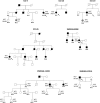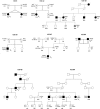Survey of familial glaucoma shows a high incidence of cytochrome P450, family 1, subfamily B, polypeptide 1 (CYP1B1) mutations in non-consanguineous congenital forms in a Spanish population
- PMID: 23922489
- PMCID: PMC3733905
Survey of familial glaucoma shows a high incidence of cytochrome P450, family 1, subfamily B, polypeptide 1 (CYP1B1) mutations in non-consanguineous congenital forms in a Spanish population
Abstract
Purpose: To identify myocilin (MYOC) and cytochrome P450, family 1, subfamily B, polypeptide 1 (CYP1B1) mutations in a Spanish population with different clinical forms of familial glaucoma or ocular hypertension (OHT).
Methods: Index patients from 226 families participated in this study. Patients were diagnosed with familial glaucoma or OHT by complete ophthalmologic examination. Screening for MYOC mutations was performed in 207 index patients: 96 with adult-onset primary open-angle glaucoma (POAG), 21 with primary congenital glaucoma (PCG), 18 with juvenile-onset open-angle glaucoma (JOAG), five with Axenfeld-Rieger syndrome (ARS), and 67 with other types of glaucoma. One hundred two of the families (including all those in whom a MYOC mutation was detected) were also screened for CYP1B1 mutations: 45 POAG, 25 PCG, 21 JOAG, four ARS, and seven others.
Results: We examined 292 individuals (patients and relatives) with a positive family history of glaucoma or OHT. We identified two novel MYOC variants, p.Lys39Arg and p.Glu218Lys, in two families with POAG, and six previously reported MYOC mutations in seven families with POAG (four), JOAG (one), PCG (one), and normotensive glaucoma (one). CYP1B1 mutations were found in 16 index patients with PCG (nine), POAG (three), JOAG (two), and ARS (two).
Conclusions: The high percentage (9/25=36%) of mutations in CYP1B1 found in non-consanguineous patients with congenital glaucoma mandates genetic testing. However, the percentage of mutations (9/207=4.4%) in MYOC associated with glaucoma is relatively low in our population. The variable phenotype expression of glaucoma, even in families, cannot be explained with a digenic mechanism between MYOC and CYP1B1.
Figures



Similar articles
-
Screening of CYP1B1 and MYOC in Moroccan families with primary congenital glaucoma: three novel mutations in CYP1B1.Mol Vis. 2010 Jul 2;16:1215-26. Mol Vis. 2010. PMID: 20664688 Free PMC article.
-
Digenic inheritance of early-onset glaucoma: CYP1B1, a potential modifier gene.Am J Hum Genet. 2002 Feb;70(2):448-60. doi: 10.1086/338709. Epub 2002 Jan 3. Am J Hum Genet. 2002. PMID: 11774072 Free PMC article.
-
Mutation spectrum of CYP1B1 and MYOC genes in Korean patients with primary congenital glaucoma.Mol Vis. 2011;17:2093-101. Epub 2011 Aug 9. Mol Vis. 2011. PMID: 21850185 Free PMC article.
-
Genetics of primary glaucoma.Curr Opin Ophthalmol. 2011 Sep;22(5):347-55. doi: 10.1097/ICU.0b013e32834922d2. Curr Opin Ophthalmol. 2011. PMID: 21730848 Review.
-
Glaucoma in iran and contributions of studies in iran to the understanding of the etiology of glaucoma.J Ophthalmic Vis Res. 2015 Jan-Mar;10(1):68-76. doi: 10.4103/2008-322X.156120. J Ophthalmic Vis Res. 2015. PMID: 26005556 Free PMC article. Review.
Cited by
-
CYP1B1 copy number variation is not a major contributor to primary congenital glaucoma.Mol Vis. 2015 Feb 11;21:160-4. eCollection 2015. Mol Vis. 2015. PMID: 25750510 Free PMC article.
-
Primary congenital glaucoma due to paternal uniparental isodisomy of chromosome 2 and CYP1B1 deletion.Mol Genet Genomic Med. 2019 Aug;7(8):e774. doi: 10.1002/mgg3.774. Epub 2019 Jun 28. Mol Genet Genomic Med. 2019. PMID: 31251480 Free PMC article.
-
Analysis of CYP1B1 in pediatric and adult glaucoma and other ocular phenotypes.Mol Vis. 2016 Oct 17;22:1229-1238. eCollection 2016. Mol Vis. 2016. PMID: 27777502 Free PMC article.
-
Carrier frequency of CYP1B1 mutations in the United States (an American Ophthalmological Society thesis).Trans Am Ophthalmol Soc. 2014 Jul;112:94-102. Trans Am Ophthalmol Soc. 2014. PMID: 25646030 Free PMC article.
-
Genotype-Phenotype Correlations in CYP1B1-Associated Primary Congenital Glaucoma Patients Representing Two Large Cohorts from India and Brazil.PLoS One. 2015 May 15;10(5):e0127147. doi: 10.1371/journal.pone.0127147. eCollection 2015. PLoS One. 2015. PMID: 25978063 Free PMC article.
References
-
- Several authors. Special Issue. (Glaucoma Review) Invest Ophthalmol Vis Sci. 2012;53:53. - PubMed
-
- Lander ES, Shork NJ. Genetic dissection of complex traits. Science. 1994;265:2037–48. - PubMed
-
- Stone EM, Fingert JH, Alward WL, Nguyen TD, Polansky JR, Sunden SL, Nishimura D, Clark AF, Nystuen A, Nichols BE, Mackey DA, Ritch R, Kalenak JW, Craven ER, Sheffield VC. Identification of a gene that causes primary open angle glaucoma. Science. 1997;275:668–70. - PubMed
-
- Stoilov I, Akarsu AN, Sarfarazi M. Identification of three different truncating mutations in cytochrome P4501B1 (CYP1B1) as the principal cause of primary congenital glaucoma (Buphthalmos) in families linked to the GLC3A locus on some 2p21. Hum Mol Genet. 1997;6:641–7. - PubMed
-
- Rezaie T, Child A, Hitchings R, Brice G, Miller L, Coca-Prados M, Heon E, Krupin T, Ritch R, Kreutzer D, Crick RP, Sarfarazi M. Adult-onset primary open-angle glaucoma caused by mutations in optineurin. Science. 2002;295:1077–9. - PubMed
Publication types
MeSH terms
Substances
Supplementary concepts
LinkOut - more resources
Full Text Sources
Medical
